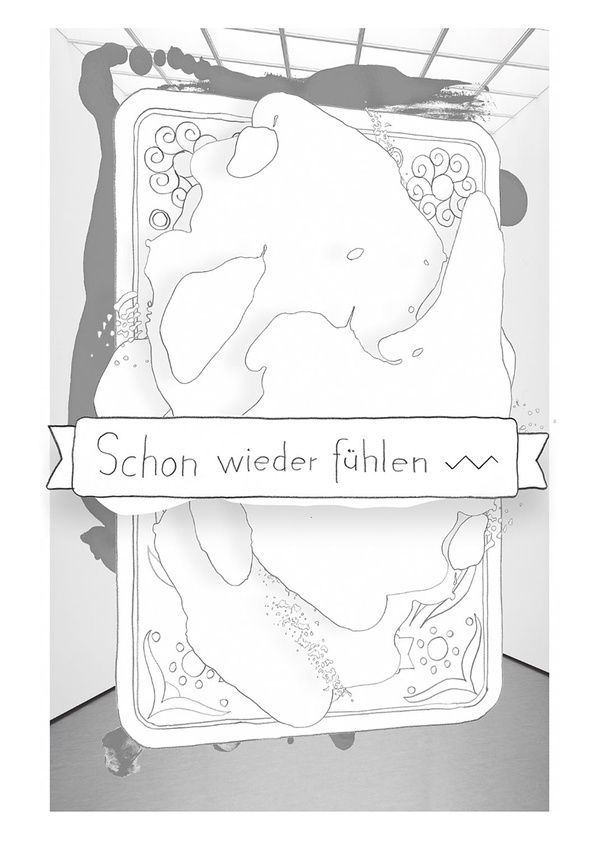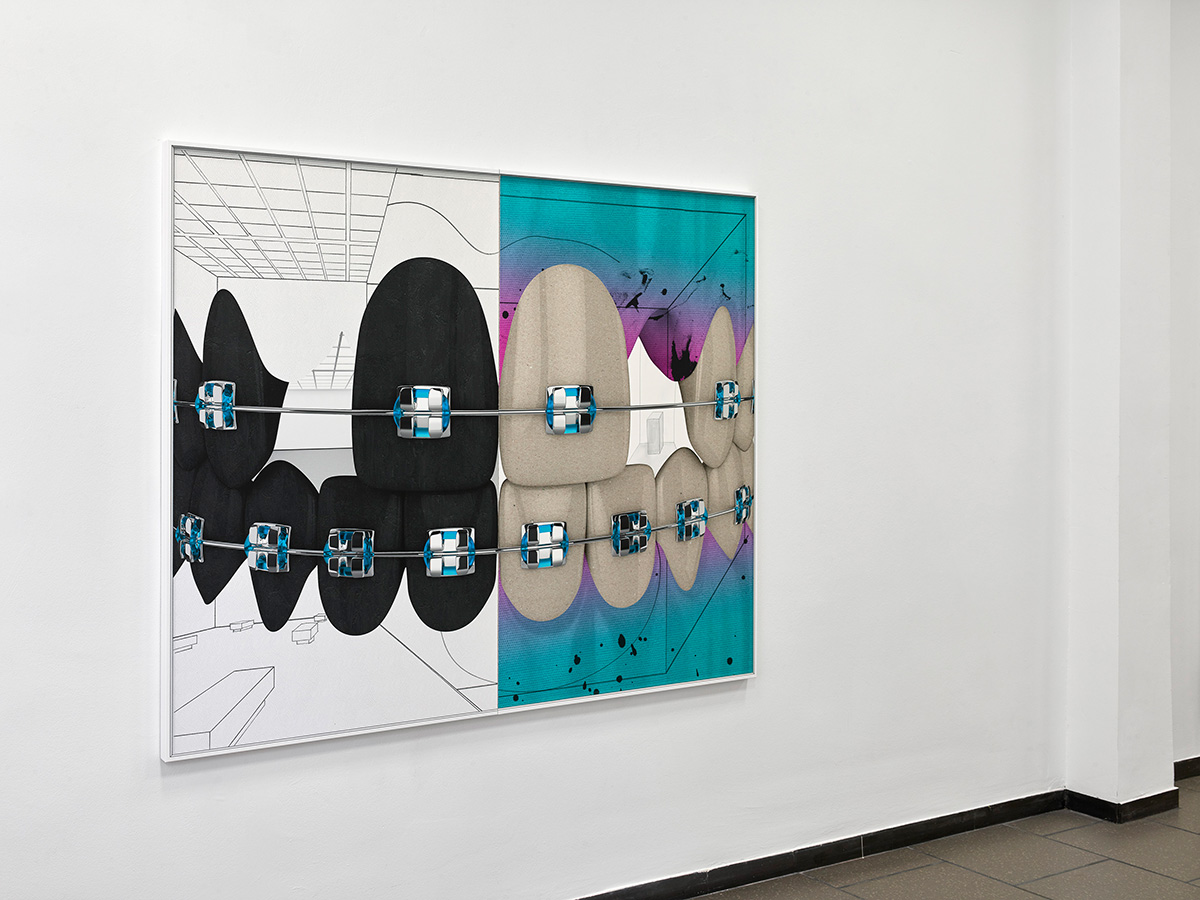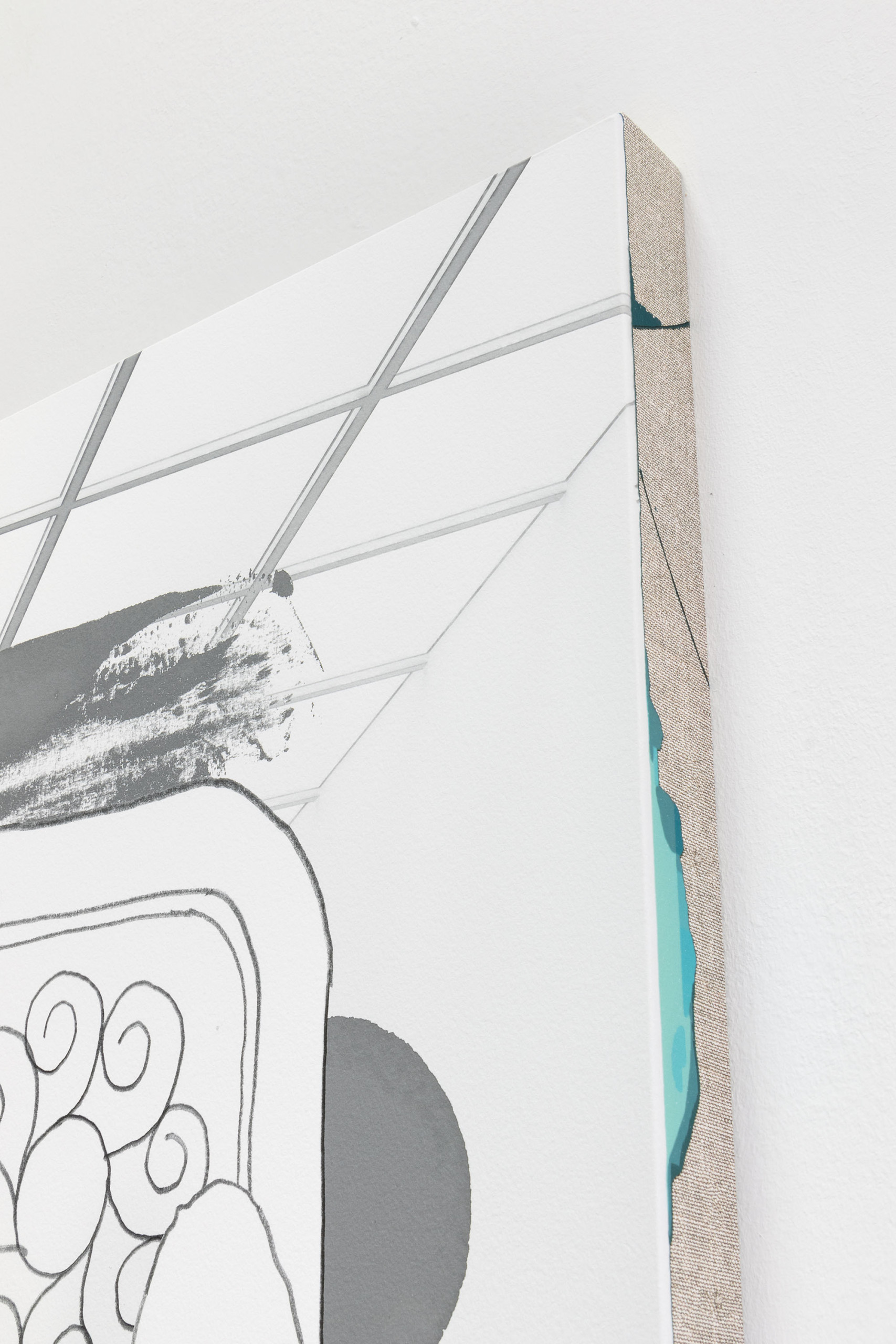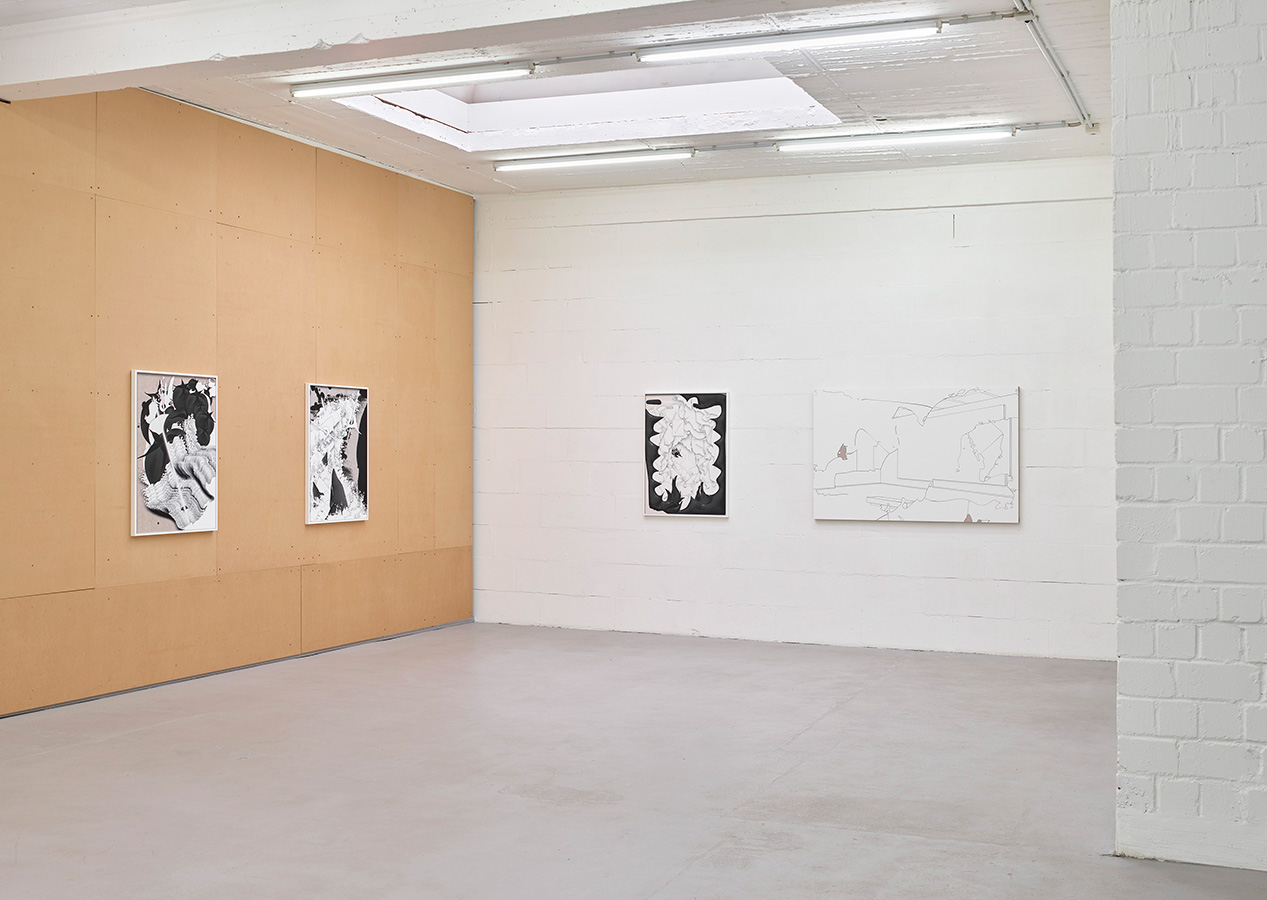Johannes Bendzulla
Schon wieder fühlen
Nov 16, 2019–Jan 10, 2020
“feeling again”
Johannes Bendzulla traces contemporary phenomena and the conditions of artistic, mostly digital image production, as well as considering the expectations that are placed on products of the “creative industry”—in the broadest sense—with regard to authorship and authenticity. In his work process, Bendzulla often reacts to moments where, as part of a commercialized appropriation, that which is supposedly freethinking is transformed into a standardized platitude.
The exhibition feeling again gathers together visual set pieces that aim to evoke the spirit of artistic work anew: depictions of empty exhibition spaces together with fluorescent lighting, canvas material, and painted and drawn elements, which, in their combination as a digital collage, seek to exude the spirit of individual creativity. Another recurring motif is the icon of the artist’s paint palette with a paintbrush that is used in classic computer programs such as Paint. Due to the distortions, reminiscent of tribal designs, the icon can only be recognized by its paintbrush, while in The Jury it could be also identified as a creature’s face. In most of the works, one encounters abstract, monochrome color fields that are created by tracing and then scanning splotches of paint. As an integral element of a now outdated advertising aesthetic, the color splash technique as such aims to convey a dynamic artistic message: this is where work took place, where the making and creating happened. In the act of seemingly endlessly copying these gestures, which always remain the same, Bendzulla staggers the splashes to form abstract structures in The Pest, The hand that feeds, and The Jury, which, on closer inspection, each consist of a single form, while tomatoes and sharks romp between them. In keeping with the idea of working efficiently, Bendzulla uses 3D and rendering programs for modeling the sculptural bodies and simple shadowing, thus giving the works the minimum pictorial depth necessary to satisfy initial scrutiny.
As in his previous series, Bendzulla negotiates the interface of digital, photographic, and “real” source materials, as well as their seamless blending together. This is occasionally expressed in the semblance of physical authenticity. The printed fibers of the canvas material or chipboard acquire a trompe l’oeil-style character through the use of handmade paper; with pencil markings and streaks of color, the structures of the scanned and enlarged drawings also seem so astonishingly real that the works always remain at the limits of the illusory.
On the one hand, feeling again can be interpreted literally, as if the works, contrary to the printed surface, indeed intend to convey a tactile feeling—or at least appear as if they do. The culmination of this carefully maintained “pretense” can be found by inspecting the edges of the images, which give the impression that the works are actually stretched across a frame. It is believable enough to satisfy an initial impression, which is frequently a common mode of viewing a work. The gaze does not amble, it only notices, perceiving the ups and downs that are enough to create the impression of realistic imitation.
On the other hand, the title could in fact be intended to express an overload of that which cannot be immediately understood, which cannot be filtered by one’s own gaze. Something that persists and can withstand the interchangeability of an anonymous mass of images seems almost unfamiliar and unsettling today. For what is perceived as “new” in the course of digitalization and the perpetual repetition caused by the constant circulation of images is ultimately a euphemism for that which seems to be working well at that precise moment; emotion of any kind is therefore hardly necessary.
Jonas Schenk
translation by Good & Cheap
“schon wieder fühlen”
Johannes Bendzulla spürt zeitgeistigen Phänomenen und Bedingungen künstlerischer, meist digitaler Bildproduktion nach und befasst sich mit Erwartungen an Autorschaft und Authentizität, die an Produkte der „Kreativwirtschaft“ im weitesten Sinne gestellt werden. In seinem Arbeitprozess reagiert Bendzulla häufig auf Momente, in denen sich das vermeintlich Freigeistige im Zuge kommerzialisierender Vereinnahmung zur standartisierten Platitüde wandelt.
In der Ausstellung „Schon wieder fühlen“ versammeln sich visuelle Versatzstücke, die abermals den Geist künstlerischer Arbeit heraufbeschwören wollen: Darstellungen von leeren Ausstellungsräumen samt Neonbeleuchtung, Leinwandstoff sowie gemalten und gezeichneten Elementen, die in ihrer Kombinierung als digitale Collage den „Spirit“ individueller Kreativität versprühen wollen. Ein anderes wiederkehrendes Motiv ist das Icon der Farb- oder Künstlerpalette mit Pinsel, welches beispielsweise für klassische Programme wie Paint verwendet wird. Durch die an Tribal-Formen erinnernde Verfremdungen bleibt das Icon einzig am Pinsel erkennbar, während man wiederum in „The Jury“ das Gesicht eines Wesens zu entdecken meint. In den meisten Werken begegnen einem abstrakte, monochrome Farbfelder, bei denen es sich um abgepauste und anschließend eingescannte Farbklekse handelt. Als fester Bestandteil einer mittlerweile gealterten Werbeästhetik will der Farbsplash als solches eine dynamische und künstlerische Botschaft vermitteln: Hier wurde gearbeitet, geschaffen, kreiert. In dem Akt des scheinbar endlosen Kopierens eines immer gleichen Gestus, staffelt Bendzulla die Splashes in „The Pest“ „The hand that feeds“ und ,“The Jury“ zu abstrakten Gebilden zusammen, die bei genauer Betrachtung aus jeweils einer einzigen Form bestehen – während sich zwischen ihnen Tomaten oder Haie tummeln. Ganz im Sinne des effizienten Arbeitens verleiht Bendzulla mit Hilfe von Rendering- und 3D-Programmen den Werken durch Modellierung der plastischen Körper oder einfacher Schattenwürfe ein Mindestmaß an Bildtiefe, den es benötigt, um die Bestandsaufnahme eines ersten prüfenden Blickes zu befriedigen.
Wie in seinen vorherigen Serien verhandelt Bendzulla die Schnittstelle von digitalen, fotografischen und „realen“ Quellenmaterials und dessen reibungslose Vermengung miteinander, was sich mitunter in dem Schein physischer Echtheit äußert. Durch die Verwendung von Büttenpapier bekommen die gedruckten Fasern von Leinwandstoff oder Graupappe einen Trompe-l’œil-artigen Charakter; auch die Strukturen der gescannten und vergrößerten Zeichnungen mit Bleistift und Farbschlieren scheinen verblüffend echt, sodass die Arbeiten stets an der Grenze des Vermeintlichen bleiben.
“Schon wieder fühlen” liest sich einerseits wortwörtlich, als dass die Werke, entgegen der gedruckten Oberfläche, durchaus ein taktiles Gefühl zu vermitteln meinen – oder zumindest so tun als ob. Wie sorgfältig dieser “Schein” aufrechterhalten wird, gipfelt in der Betrachtung der Bildränder, wenn man glaubt, dass die Arbeiten tatsächlich auf einen Keilrahmen gespannt seien. Es genügt für die Wahrung eines ersten Eindrucks, der wie so häufig ein gängiger Modus der Betrachtung ist. Der Blick flaniert nicht, er registriert nur; nimmt Höhen und Tiefen wahr, was genügt, um den Anschein realistischer Nachahmung zu erwecken.
Anderseits meint der Titel gar eine Überforderung dessen auszudrücken, was nicht sofort verstanden werden kann, was nicht vom eigenen Blick gefiltert werden kann. Etwas, was anhält und sich der Austauschbarkeit aus einer anonymen Bildmasse heraus entzieht scheint heute nahezu ungewohnt und irritierend. Denn was im Zuge der Digitalisierung und der ewigen Wiederholung aus einem fließenden Umlauf von Bildern als “Neu“ empfunden wird, ist letztlich ein Euphemismus für das, was gerade zu funktionieren scheint; eine Regung jeglicher Art bedarf es daher eher kaum.
Jonas Schenk






















